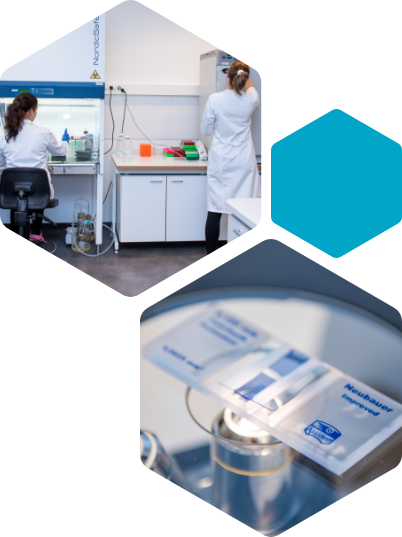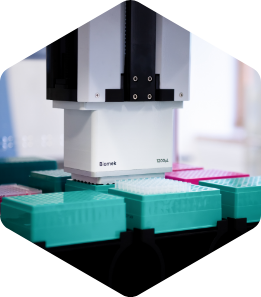Our services for Biologics research
Biological drugs include a wide range of drug modalities, such as peptides, monoclonal antibodies, proteins, and oligonucleotides, which require tailored experimental protocols and analytical techniques for their successful ADME-Tox and in vivo DMPK characterization.
Regardless of the drug modality, we can support the project for investigating metabolic stability, plasma protein binding, drug-drug interaction studies and in vivo pharmacokinetic studies.
Besides investigating ADME/DMPK properties, structural characterization is an essential part of the development process of larger biologics, such as mAbs and ADCs. Liquid chromatography – mass spectrometry (LC-MS) based techniques are excellent for this, providing unambiguous structural and quantitative information. Use of state-of-the-art analytical instrumentation and software allows straightforward sample analysis and delivers reliable high-quality results. In addition, enzyme-linked immunosorbent-assays (ELISA) are an efficient and convenient way to quantify proteins, when the needed antibody is available.
In addition to structural characterization of biological drugs, we can also perform targeted protein quantification (LC-MS and ELISA), in vivo pharmacokinetic studies and biomolecular interactions, and characterize ADCs for their ADME properties.
Reach out to us to discuss how we can support with your project!
ADC Characterization
Antibody-drug conjugates (ADCs) consist of small molecules (warhead/payload) linked to antibodies. The linker between small molecule and the antibody affects the payload release mechanism via metabolic reactions. Therefore, when studying ADME properties of ADCs it´s important to identify the released metabolites, including unconjugated small molecule drug, small molecule conjugated to the linker or some parts of the linker, and small molecule conjugated to the linker and amino acid residues of the antibody. ADC catabolism is typically investigated in acidic conditions using liver S9 fraction and lysosomes. In vitro metabolite identification and profiling for payload and linker payload is conducted in neutral conditions with liver S9 fraction.

Depending on the conjugation strategy, the developed ADCs may vary in the number of payload conjugated per antibody molecule. The average number of payload in the antibody is defined as drug-antibody ratio (DAR). It is essential to define DAR since it affects the efficacy of ADCs and the metabolites. DAR can be determined by analyzing intact protein using LC-HR/MS. Prior to analysis, protein is typically enzymatically deglycosylated to remove carbohydrate structures since this simplifies the analysis.
As well as studying how small molecules are released from ADCs, we can investigate rodent pharmacokinetics of ADCs in our in-house animal facilities.
Oligonucleotides
Despite oligonucleotides are different from traditional small molecules, it is crucial to investigate also their ADME-Tox/DMPK properties to avoid failure at the later stages due to poor ADME performance or safety issues. In particular, the metabolic stability, metabolite identification, plasma protein binding, and drug-drug interactions are typically evaluated. Admescope’s portfolio includes ADME-Tox and in vivo DMPK assays for oligonucleotides, as well as other drug modalities. Our experienced scientific team is equipped with high-end analytical instrumentation and available to support your oligonucleotide project.
The in vitro metabolism and metabolite identification experiments for oligonucleotides are available with various enzymatic matrices, such as plasma, liver and kidney fractions. However, special considerations are needed when designing experimental protocols, sample treatment and analytical method development for oligonucleotides. Due to the high stability of therapeutic oligonucleotides with phosphorothioate or phosphorodiamidate morpholino backbone, long incubation times are typically used, and when applying cell-based models, co-culture models for low clearance compounds are recommended, as the incubation times can be extended over several days.
For plasma protein binding determination of oligonucleotides, ultrafiltration method is a commonly used approach, using filters with 30 – 50 kDa cut-off suitable for oligonucleotides, and coupled with several pre-washing steps of the filter, e.g using a detergent solution. Our preclinical in vivo DMPK services for oligonucleotides include the whole study package; conduction of in-life part, bioanalysis with LC-MS or qPCR, data processing and reporting.
Quantification with LC-MS
To quantify proteins from biological matrixes, larger proteins (>10-20 kDa) are analyzed using digestion and surrogate peptide approach, whereas smaller proteins and peptides can be quantified as intact with UV with or without MS-detection, although the method of choice depends also on the sample matrix.
Protein quantification using surrogate peptide approach with LC-MS starts with bioinformatics, instead of antibody sourcing or development like in traditional immunoassays (e.g., ELISA). Therefore, the method development time can be significantly shorter compared to the antibody-binding based analytical techniques. The target protein sequence is first compared with the sample matrix proteome and the predicted peptides, unique for the target protein, are identified. Next, the target protein is enriched, or the background proteome depleted using, for example, selective precipitation or solid phase extraction. This is followed by protein digestion, using sequence specific proteases, to liberate the predicted peptides from the target protein. The target protein quantification is then based on monitoring LC-MS signal of the unique target peptides.

Quantification with ELISA
ELISA methods have been applied for protein quantification from biological matrixes over decades. When an antibody for the target protein is available, quantification using ELISA is sensitive and specific alternative, requiring relatively low sample volumes.
We offer protein quantification using commercially available ELISA kits, assays provided by the customer or we can develop ELISA methods when there is an antibody or antibody pair available for the target protein. The assays can be customized, optimized and verified according to your requirements.
ELISA is an efficient technique and the results correlate with the LC-MS/MS approach. Optimal protein quantification would use two independent analysis (i.e., ELISA + LC-MS/MS).
Protein Pharmacokinetics
Our in-house animal facilities enable us to perform protein PK studies with mice and rats, and other species are available via European subcontractors. In addition, we offer bioanalysis to quantify proteins and PK parameters can be calculated. For additional information, please go to animal pharmacokinetics.
Protein MW and Structural Characterization (LC-MS)
Intact molecular weight analysis of protein by mass spectrometry is a fast and efficient way to confirm purity, homogeneity and molecular weight of the protein analyte. The samples are analyzed using high resolution LC-MS system. In the case of antibodies, various treatments can be applied to verify the molecular weights of heavy and light chains of the antibody or other enzymatically produced sub-units, to enable more precise characterization of the target molecule. In addition, the effect of different glycosylations or other post-translational modifications on the molecular weight can be observed.
Peptide Mapping and Detection of Post-translational Modifications (LC-MS)

To further help with the structural characterization of proteins, we provide peptide mapping to verify and elucidate the amino acid sequence of the target protein. This technique is also recognized by the International Council of Harmonization (ICHQ6B) as part of physicochemical characterization of biological products.
Typically, the expected sequence of the target protein is mapped against experimental result of the target based on analysis of sequence-related peptides originating from digestions under several enzymatic conditions. In addition to the information of the primary structure, this analysis can detect the post translational modifications and their locations within the known sequence.
Released N-glycan Profiling
Glycosylation is one of the most frequent protein post-translational modifications, which may affect the stability, immunogenicity, pharmacokinetics and biological activity of the protein. Therefore, comprehensive characterization and monitoring of glycans is an essential task in development of biologics. Characterization of released glycans provides more comprehensive information about the glycan profile in comparison to analysis of the intact glycoprotein.
In the released N-glycan profiling, the protein is first deglycosylated to release N-glycans, which is followed by labelling, purification, and detection of the fluorophore labelled N-glycans. N-glycans are separated using chromatography and detected based on the sensitive fluorescence signal. A glycan library is used to identify the glycan structures based on their retention time and identification is confirmed with LC-MS.
Biomolecular Interactions
Surface plasmon resonance (SPR) and bio-layer interferometry (BLI) are label-free techniques which are used to investigate biomolecular interactions. They are especially suitable for characterizing antibody-antigen interactions and Fc-related antibody-effector interactions. In these techniques, the ligand is captured on the biosensor surface and binding of the analyte is investigated and information on the association and dissociation kinetics is obtained.

We provide SPR and BLI analyses to characterize protein-protein (e.g., antibody-antigen), antibody – FcRn and antibody – FcγR interactions. While measurements for ranking of antibody candidates can be done using single concentrations, determination of the kinetic parameters typically requires analysis using multiple concentrations. When investigating antibody – FcRn receptor interactions, the binding is studied at two different pH conditions, which are relevant for antibody recycling. For investigating FcRn interactions, receptors of various preclinical species and human are available. For FcγR-related interactions, we provide analysis of mAb binding affinity on human FcγRI, FcγRIIA (H/R131), FcγRIIB, FcγRIIIA (V/F158) and FcγRIIIB.
